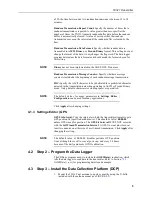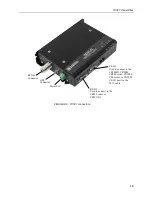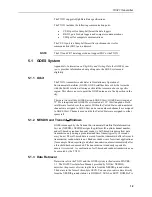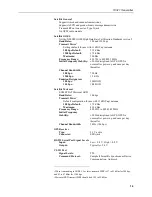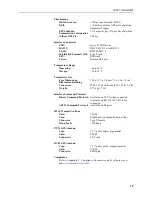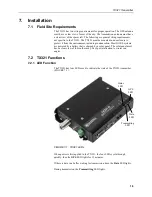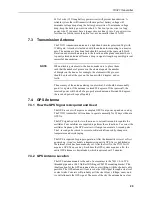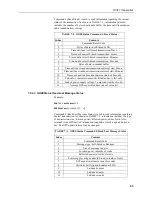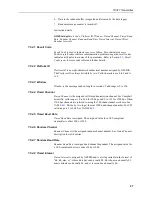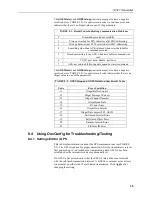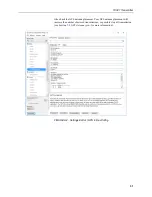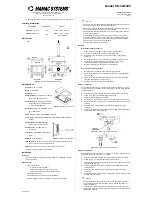
TX321 Transmitter
19
The RS-232 port allows the transmitter to be connected to a computer 9-pin
serial port or to a data logger RS-232 port. Connection to a computer is
required to configure the transmitter via
DevConfig
.
7.2.2.3 USB Port
The transmitter also has a micro B USB port for connecting to a computer.
Many newer computers only have USB ports. Configuration of the transmitter
via
DevConfig
requires that the transmitter is connected to a computer.
7.2.3 RF Connectors
7.2.3.1 RF Transmission Connector
The TX321 uses the type N female connector for RF power out. This connector
must have a proper antenna connection before transmission occurs. Failure to
use a properly matched antenna cable and antenna may cause permanent
damage to the RF amplifiers. The nominal impedance is 50 ohms; the
frequency range is approximately 400 to 403 MHz. For GOES at 300 bps
transmission rates, the default transmit power is 31.5 dBm. At 1200 bps, the
default transmit power is 37.5 dBm. (Campbell Scientific standards use about 6
dBm higher power.) For Meteosat, the default transmit power is 37.5 dBm.
7.2.3.2 GPS Connector
The GPS connector is an input to the TX321. Operation without an antenna
connected will not cause damage, but the transmitter will not transmit without
a valid GPS fix. The GPS connector is an SMA female. The GPS receiver uses
an active 3.3 V antenna.
The TX321 transmitter uses the GPS receiver for two functions. The precise
GPS time is used to ensure scheduled transmissions occur at the proper time.
The one-second GPS synchronization pulse is used to ensure a precise, drift-
free carrier frequency. See Section
(p. 20)
, for more
information regarding GPS and GPS antenna placement.
7.2.4 Power Connector
The TX321 power connector has two pins: ground and 12 V. The input power
requirement is 10.8 to 16 VDC at 3 A. Because the TX321 can use up to 3 A,
the power should be connected directly to the battery.
With the potential for a 3000 mA current drain, the voltage drop along the
battery power wires must be considered. The battery power wires run from the
battery to the power input connectors of the TX321. To calculate the voltage
drop along the power wires, we must know the resistance of the wire and the
length of the wire. Usually the resistance of the wire is listed as ohms per 1000
feet. For example, a 24 AWG wire used by Campbell Scientific has a
resistance of 23 ohms per 1000 feet. The length of the wire is the distance the
wire travels from the battery to the transmitter multiplied by two. You must
consider the current travels from the battery to the transmitter and back to the
battery.
The TX321 will operate with a battery voltage range from 10.8 to 16 V. A fully
charged lead acid battery will have a voltage of about 12.5 V. If the battery is
fully charged, a 1.7 V drop along the battery wires will stop the transmitter
from transmitting. At 3 A, 1.7 V will be dropped with 0.566 ohms of
resistance. Using the 24 AWG wire with 23 ohms resistance per 1000 ft,
Summary of Contents for TX321
Page 1: ...TX321 Transmitter Revision 5 19 Copyright 2000 2019 Campbell Scientific ...
Page 2: ......
Page 4: ......
Page 6: ......
Page 8: ......
Page 46: ......
Page 48: ......
Page 56: ......
Page 82: ......
Page 84: ...AppendixE Meteosat F 2 FIGURE F 2 DCPRS and CGMS certificate ...
Page 85: ...AppendixE Meteosat F 3 FIGURE F 3 EUMETSAT certificate ...

